2. 中国科学院地质与地球物理研究所, 岩石圈演化国家重点实验室, 北京 100029;
3. 中国科学院大学地球与行星科学学院, 北京 100049
2. State Key Laboratory of Lithospheric Evolution, Institute of Geology and Geophysics, Chinese Academy of Sciences, Beijing 100029, China;
3. College of Earth and Planetary Sciences, University of Chinese Academy of Sciences, Beijing 100049, China
在花岗岩的各种分类中,ISAM(即I、S、A、M型)分类应用最为广泛。其中,I型和S型花岗岩是以岩浆源区性质来区分,I型花岗岩来自火成岩的部分熔融,而S型花岗岩来自(变)沉积岩的部分熔融(Chappell and White, 1974)。由于岩浆源区岩石受到了风化作用的影响,S型花岗岩最重要化学组成特征是强过铝(铝饱和指数A/CNK>1.1),同时具有相对I型花岗岩较低的Na2O、CaO、Sr含量和较高的Sr和O同位素组成,相应的矿物组成特征是含白云母、堇青石和石榴子石等过铝质矿物(Chappell and White, 1974)。根据过铝质矿物的不同,常见的S型花岗岩可以分为两类:含白云母的S型花岗岩和含堇青石的S型花岗岩(Barbarin, 1996)。含白云母S型花岗岩富SiO2(71%~76%),贫MgO+FeOT(< 3%),成分接近最低共熔点组分,形成温度较低,主要是白云母脱水熔融的产物,典型代表为高喜马拉雅淡色花岗岩(Patiño Douce and Harris, 1998; Patiño Douce, 1999)。含堇青石S型花岗岩的SiO2含量范围主要在65%~74%,高MgO+FeOT(1%~9%),成分相对偏基性,形成温度较高,多为黑云母脱水熔融的产物,典型代表为澳大利亚Lachlan褶皱带S型花岗岩(Chappell and White, 1992, 2001)。
华北克拉通孔兹岩带东段凉城地区发育有大规模古元古代石榴石花岗岩,在化学组成上表现为强过铝的特征,其中的镁铁质矿物不仅有石榴子石和黑云母,有时还有紫苏辉石,这明显不同于典型的S型花岗岩(白云母花岗岩和堇青石花岗岩)。此外,凉城石榴石花岗岩具有低SiO2(55%~70%)、富镁铁(MgO+FeOT=5%~15%)的地球化学特征(翟明国等, 1996; Peng et al., 2012; Wang et al., 2018),偏离了正常花岗岩的成分范围。对比全球海量花岗岩化学组成数据,我们发现具有类似特征的花岗岩极为少见,因此认为,凉城石榴石花岗岩可能代表了一类特殊类型的S型花岗岩,其岩石成因机制也具有特殊的科学意义,值得深入探讨。我们此前详细论述过凉城石榴石花岗岩的岩石学、地球化学和年代学特征,提出凉城石榴石花岗岩的形成与超高温变质作用和幔源岩浆活动密切相关(Peng et al., 2012; Wang et al., 2018)。本文则从S型花岗岩成因研究的角度,着重阐述凉城石榴石花岗岩作为S型花岗岩的特殊性,介绍我们新的见解,并结合全球对比,阐述这类特殊S型花岗岩的重要岩石学意义。
1 地质概况华北克拉通孔兹岩带是西部陆块内部的一条近东-西向展布、长达1000km的陆-陆碰撞构造带,由北部的阴山陆块和南部的鄂尔多斯陆块于~1.95Ga碰撞形成(Zhao et al., 2003, 2005; Yin et al., 2009, 2011)。孔兹岩带东段集宁-凉城地区是前寒武纪高级变质基底出露区,出露古元古代高温-超高温麻粒岩相变质沉积岩、S型花岗岩和徐武家辉长苏长岩小侵入体群(图 1)。变质沉积岩主要包括富铝夕线石榴钾长(二长)片麻岩和黑云石榴钾长(二长)片麻岩,以及少量石墨片麻岩、大理岩和钙硅酸盐岩(卢良兆等, 1996)。该地区麻粒岩相变质岩石记录了顺时针P-T变质作用轨迹,峰期温压条件在800~900℃、9~12kbar(Lu and Jin, 1993; 卢良兆等, 1996; Wang et al., 2011; 王洛娟等, 2011; Jiao et al., 2013; Cai et al., 2017)。近年来,在集宁天皮山、土贵山、徐武家和红寺沟地区、和林格尔南天门和小南沟地区、凉城徐麻夭、鞍子山和桃花沟地区、大同孤山地区、卓资红砂坝地区陆续识别出~1.92Ga超高温麻粒岩(Santosh et al., 2006, 2007; Jiao and Guo, 2011; Jiao et al., 2011; Liu et al., 2012; Zhang et al., 2012; Yang et al., 2014; 王洛娟, 2015; Li and Wei, 2016, 2019; Lobjoie et al., 2018)。
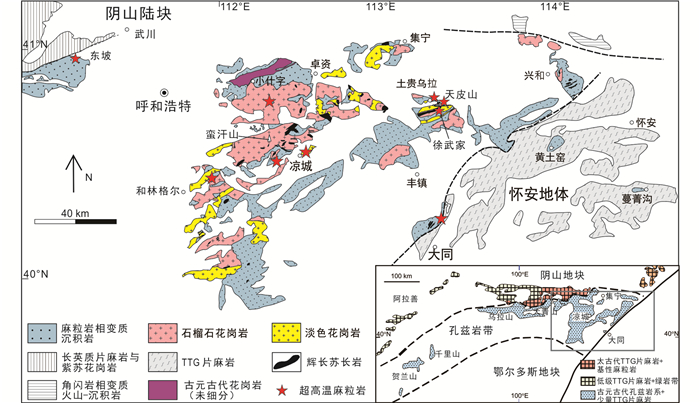
|
图 1 华北克拉通孔兹岩带东段早前寒武纪高级变质岩的分布(据郭敬辉等, 2002; Zhao et al., 2005; Peng et al., 2012修改) Fig. 1 Distribution of the Early Precambrian high-grade metamorphic rocks in the eastern part of the Khondalite Belt, North China Craton (modified after Guo et al., 2001; Zhao et al., 2005; Peng et al., 2012) |
在麻粒岩相变质沉积岩背景上,集宁-凉城地区还发育有大面积侵入岩。区内侵入岩主要包括三类:(1)较早的花岗岩类侵入体,包括2.2~2.1Ga紫苏花岗岩和1.95Ga淡色花岗岩,均经历了麻粒岩相变质作用,后者形成于俯冲碰撞地壳增厚的进变质过程中高角闪岩相深熔阶段,是变沉积岩水致白云母部分熔融作用的产物,典型出露区在凉城县以北的鞍子山-五苏木一带(Wang et al., 2017)。(2)1.93~1.92Ga石榴石花岗岩,出露面积相当于研究区内前寒武纪基底分布区的40%~50%,岩石类型以黑云石榴花岗岩和紫苏石榴花岗岩为主,是高温型的强过铝S型花岗岩(Peng et al., 2012; Wang et al., 2018),在缓慢冷却过程中经历了1.92~1.91Ga自变质作用,无变形或弱变形(Wang et al., 2018)。(3)~1.93Ga辉长质-苏长质-闪长质的小侵入体群,以大小不等的岩墙、岩席和小侵入体的形式分布在变沉积岩和石榴石花岗岩中。这类基性岩体共有几十个,规模从几百米到几千米,最大的是徐武家岩体,故将此套岩石系列命名为徐武家辉长苏长岩(Peng et al., 2010)。辉长苏长岩经历了麻粒岩相变质变形作用,发育典型的二辉麻粒岩变质矿物组合。
凉城石榴石花岗岩是产于麻粒岩相变质沉积岩背景中的近原地-半原地花岗岩,花岗岩主体与围岩变沉积岩呈侵入接触关系,在凉城蛮汗山一带构成岩性较为均匀的巨大岩体,面积可达400km2,局部与围岩变沉积岩呈渐变过渡关系。在卓资南部大榆树一带,石榴石花岗岩并没有构成岩性均匀的岩体,而是一系列不规则分布的混合花岗岩体(或称为dirty granite),含有大量规模不等的夕线石榴片麻岩包体(卢良兆等, 1996; 陶继雄和胡凤翔, 2002)。本文主要论述凉城一带岩性均匀的石榴石花岗岩。石榴石花岗岩中常见变沉积岩包体,长径多为几十厘米到几米,岩性主要为夕线石榴钾长片麻岩和黑云石榴钾长片麻岩,保留片麻状构造(图 2a),也见无片麻状构造的含石榴石尖晶石钾长麻粒岩(图 2b)。石榴石花岗岩中还可见肉红色含石榴石钾长花岗岩脉(宽0.5~2m)。
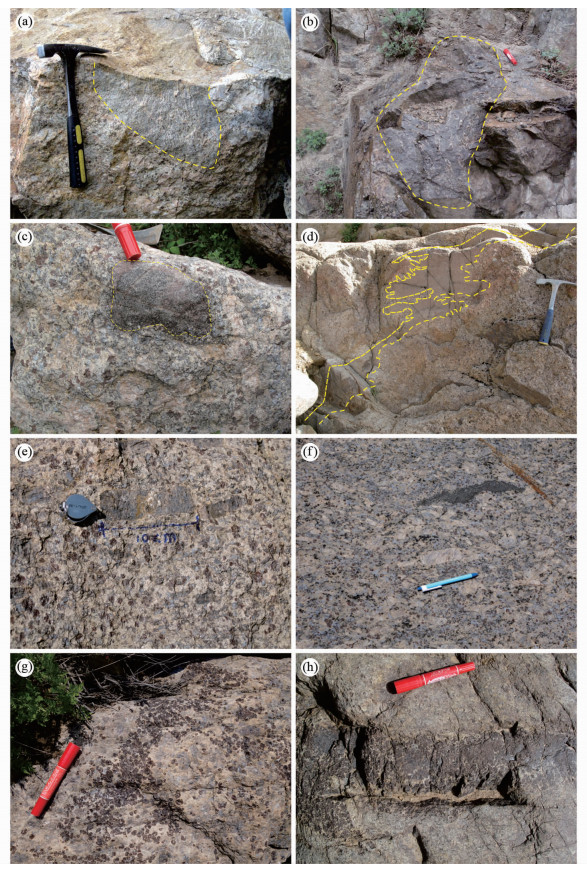
|
图 2 凉城石榴石花岗岩野外照片 (a)花岗岩中的夕线石榴片麻岩包体;(b)花岗岩中含石榴石尖晶石钾长麻粒岩包体;(c)花岗岩中辉长苏长岩包体,包体内及接触边界发育石榴子石;(d)花岗岩中的基性同深成岩墙;(e)黑云石榴花岗岩;(f)紫苏石榴花岗岩;(g、h)花岗岩中的富石榴石团块和条带 Fig. 2 Field photographs of the Liangcheng garnet granitoids |
在石榴石花岗岩中间及边部分布着数量众多的辉长苏长岩小侵入体。辉长苏长岩小侵入体大小变化从千米级到米级。较大(百米到千米级)的基性侵入体与花岗岩之间具有复杂而不规则的界线,呈现相互包裹、渐变过渡的特点,基性侵入体逐渐过渡为花岗岩中密集的基性包体群。基性侵入体中也可见花岗岩和变沉积岩包体。米级到厘米级大小的基性包体常成群分布,包体形态多为椭圆状、透镜状或条带状,与寄主花岗岩边界呈弥散状,有时可见边界处发育1~5cm富黑云母石榴石反应边或5~10cm宽的混合过渡带(图 2c)。在石榴石花岗岩中,也见基性同深成岩墙(图 2d)。基性包体和同深成岩墙呈灰黑色,中细粒结构,片麻理不明显,矿物组合为斜长石+紫苏辉石+黑云母+石英+钾长石±单斜辉石±石榴子石。
2 岩石学与矿物学特征凉城石榴石花岗岩具有粗粒似斑状结构,块状构造,局部呈片麻状或糜棱状构造。主要矿物组合为石榴子石(5%~15%,局部可达25%)+黑云母(2%~5%)±紫苏辉石(2%~5%)+钾长石(20%~25%)+斜长石(30%~40%)+石英(20%~30%),副矿物有尖晶石、钛铁矿、锆石、独居石、磷灰石、黄铁矿、黄铜矿等。根据矿物组合,石榴石花岗岩可以进一步分为黑云石榴花岗岩(图 2e)和紫苏石榴花岗岩(图 2f)。花岗岩中石榴子石分布不均匀,多数在5%~15%,可达25%,局部聚集成石榴石岩团块或条带(图 2g, h)。钾长石斑晶呈灰白色或肉红色,长3~6cm,个别可达10cm,局部定向排列。
根据矿物结构和包体特征,石榴子石可以分为四种类型:富含包体石榴子石、粗粒石榴子石、细粒石榴子石和环边石榴子石。富含包体石榴子石(GrtA)呈椭圆状或不规则状,粒度多为2~4mm,核(幔)部含较多包体矿物石英、黑云母、钛铁矿、尖晶石和斜长石等,而边部基本不含包体,表现出净边结构(图 3a, b);粗粒石榴子石(GrtB)呈椭圆状,粒度较大,多为3~10mm,基本不含或含有较少的包体矿物(石英、黑云母、斜长石、钛铁矿、锆石、独居石和磷灰石)(图 3c);细粒石榴子石(GrtC)呈半自形,粒度较小,多为0.5~1mm,无包体或含少量包体矿物(图 3d);环边石榴子石(GrtD)围绕暗色矿物(石榴子石、黑云母、紫苏辉石和钛铁矿)生长,类似于“红眼圈”结构,环边石榴子石宽度一般在0.1~0.5mm左右,其中包含大量的蠕虫状石英和少量的钾长石、黑云母、紫苏辉石和钛铁矿(图 3e, f)。
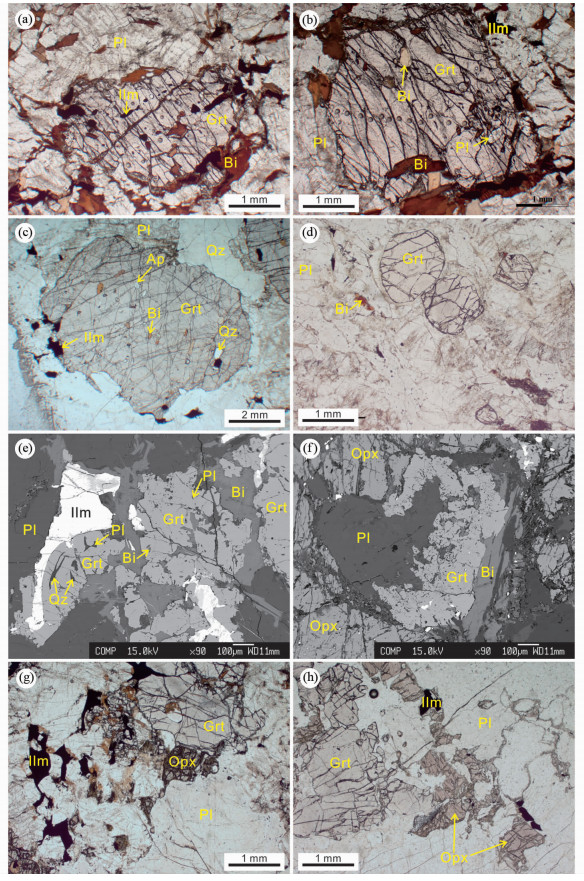
|
图 3 凉城石榴石花岗岩的显微照片和BSE图像 (a、b)花岗岩中富含包体石榴子石;(c)花岗岩中粗粒石榴子石;(d)花岗岩中细粒石榴子石;(e、f)花岗岩中环边石榴子石;(g、h)紫苏石榴花岗岩. 矿物缩写:Grt-石榴子石;Opx-紫苏辉石;Bi-黑云母;Pl-斜长石;Qz-石英;Ilm-钛铁矿;Ap-磷灰石 Fig. 3 Photomicrographs and BSE images of the Liangcheng garnet granitoids |
薄片中的黑云母呈片状,具有棕褐色-浅黄色多色性,发育扭折带。黑云母多围绕石榴子石斑晶生长,也常以包体形式出现在石榴子石斑晶内部(图 3a-c)。紫苏辉石呈粒状,浅褐色-浅绿色,多色性较弱,可见钛铁矿出溶条纹,边部有时被黑云母和石英的交生取代(图 3g, h)。钾长石斑晶出溶极细的斜长石条纹,边部常发育蠕英石,其内偶见包体矿物石榴子石、辉石、斜长石、黑云母和磷灰石。基质中的钾长石呈他形,岀溶少量斜长石条纹。斜长石为半自形,岀溶补片状或块状钾长石,发育扭折带和波状消光。石英呈他形粒状,发育波状消光、亚颗粒和核幔结构。
3 岩石地球化学特征本文系统收集了凉城-集宁地区石榴石花岗岩主微量元素数据,数据来自以下文献:石昕(1997)、陶继雄和胡凤翔(2002)、钟长汀等(2007)、Peng et al.(2010, 2012)及Wang et al. (2018)。
凉城石榴石花岗岩具有较宽泛的成分变化范围,SiO2含量为55%~75%,主要集中在58%~70%,MgO+FeOT含量较高,主要范围在5%~14%之间。Al2O3含量较高,为13%~19%,A/CNK为1.1~1.6,属于强过铝花岗岩。岩石CIPW标准矿物计算显示刚玉含量为1.9%~6.2%。CaO含量主要在2.0%~4.1%,Na2O含量为1.8%~3.4%,K2O含量为1.1%~5.8%,CaO/Na2O比值为0.4~1.7。在Harker图解上,Al2O3、FeOT、MgO和SiO2具有明显的负相关关系,TiO2、CaO、Na2O和SiO2具有较弱的负相关性,K2O、P2O5和SiO2无明显相关性(图 4,Wang et al., 2018)。石昕(1997)报道土贵乌拉地区少数富石榴石花岗岩样品具有较低的SiO2含量,为55%~58%,MgO+FeOT含量较高,为14%~15%,Al2O3含量高达20%~22%,A/CNK为2.2~4.2。CaO和Na2O含量较低,分别为0.5%~2.8%、0.6%~1.9%。K2O含量主要为2.4%~2.9%。与世界其他地区S型花岗岩以及变沉积岩实验熔体相比,凉城石榴石花岗岩具有显著的低硅、富镁铁的特征(图 5)。
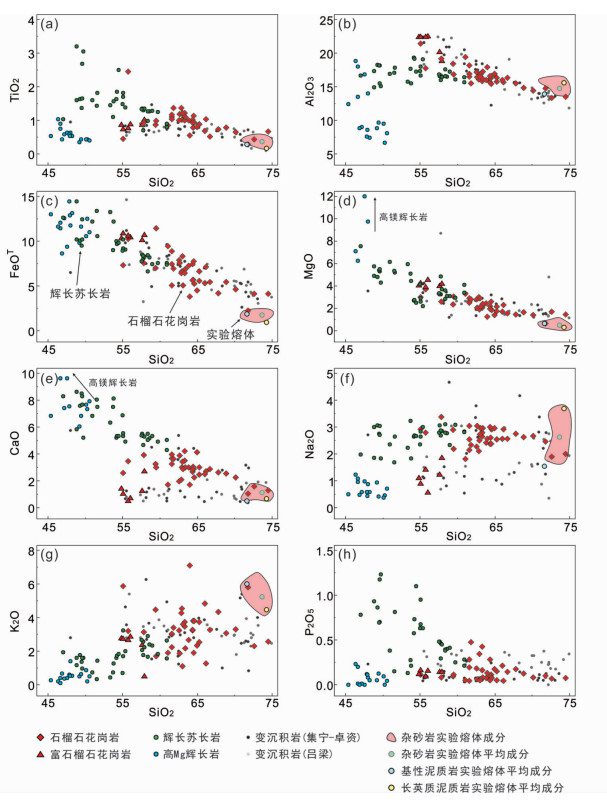
|
图 4 凉城石榴石花岗岩主量元素Harker图解(据Wang et al., 2018) 辉长苏长岩数据源自Peng et al. (2010)和作者未发表数据; 高Mg辉长岩数据源自Peng et al. (2010); 集宁-卓资变沉积岩数据源自卢良兆等(1996)和作者未发表数据; 吕梁变沉积岩数据源自李江海等(1999); 杂砂岩实验熔体数据源自Montel and Vielzeuf (1997)和Patiño Douce and McCarthy (1998); 基性泥质岩实验熔体数据来自Vielzeuf and Holloway (1988)和Patiño Douce and Johnston (1991); 长英质泥质实验熔体成分来自Patiño Douce and Harris (1998)和Patiño Douce and McCarthy (1998) Fig. 4 Plots of SiO2 vs. other major elements for Liangcheng garnet granitoids (after Wang et al., 2018) |
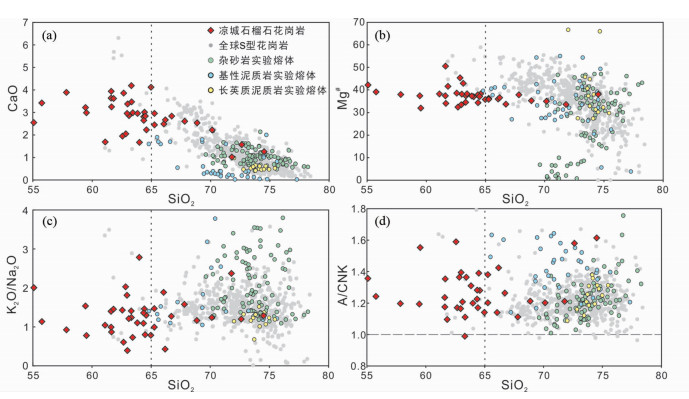
|
图 5 凉城石榴石花岗岩与全球S型花岗岩和实验熔体成分对比 全球S型花岗岩成分底图来自Clemens and Stevens (2012); 杂砂岩实验熔体数据源自Montel and Vielzeuf (1997)和Patiño Douce and McCarthy (1998); 基性泥质岩实验熔体数据来自Vielzeuf and Holloway (1988)和Patiño Douce and Johnston (1991); 长英质泥质实验熔体成分来自Patiño Douce and Harris (1998)和Patiño Douce and McCarthy (1998) Fig. 5 Compositions of Liangcheng garnet granitoids, global S-type granites and experimental melts |
凉城石榴石花岗岩具有较高的稀土总量(∑REE=241×10-6~611×10-6,个别低至188×10-6),表现为中-重等程度稀土元素分馏((La/Yb)N=4~52),主要是重稀土分异中等到不明显,具有明显负Eu异常(Eu/Eu*=0.26~0.68)(图 6a)。石榴石花岗岩相对富集Rb和Th,亏损Ba、U、Nb、Ta、Sr、P和Ti(图 6b)。Rb=48×10-6~161×10-6,Sr=170×10-6~384×10-6,Ba=493×10-6~1394×10-6,Rb/Sr比值低(0.2~0.7),Sr/Y比值低(1~17)。Zr含量较高,为242×10-6~628×10-6。岩石具有较高的Th含量(6×10-6~47×10-6,avg.=20×10-6)、较低的U含量(0.26×10-6~2.4×10-6,avg.=0.86×10-6)和较高的Th/U比值(6~41,avg.=24)。
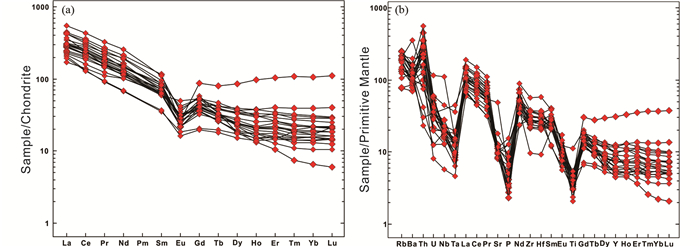
|
图 6 凉城石榴石花岗岩球粒陨石标准化稀土配分图和不相容元素原始地幔标准化图(标准化值据Sun and McDonough, 1989) Fig. 6 Chondrite-normalized rare earth element patterns and primitive mantle-normalized incompatible elements diagram for the Liangcheng garnet granitoids (normalization values after Sun and McDonough, 1989) |
陶继雄和胡凤翔(2002)和石强等(2018)分别报道的卓资和集宁石榴石花岗岩具有较低的稀土总量(75×10-6~226×10-6)和正Eu异常(0.99~2.86),个别样品具有极低的稀土总量(31×10-6、45×10-6)和显著正Eu异常(3.55、7.72)。这些样品微量元素特征可能反映了长石堆晶,明显受分离结晶过程控制。本文不再列出详细讨论。
4 年代学凉城石榴石花岗岩发育岩浆锆石和变质锆石,继承锆石很少。郭敬辉等(1999, 2002)最早利用颗粒锆石U-Pb定年技术获得1836±18Ma和1892±10Ma两组年龄。近年来,随着二次离子探针技术的发展和应用,大量的高质量定年数据涌现。钟长汀等(2007)利用SHRIMP锆石U-Pb测年技术获得石榴石花岗岩岩的形成年龄为1921±16Ma和1908±13Ma。Peng et al. (2014)利用Cameca IMS-1280获得的石榴石花岗岩锆石U-Pb年龄为1934±7Ma。Wang et al. (2018)对5个石榴石花岗岩样品进行Cameca IMS-1280 U-Pb测年,获得的岩浆锆石年龄为1936~1919Ma。Huang et al. (2019)报道的石榴石花岗岩Cameca IMS-1280岩浆锆石U-Pb年龄为1936±5Ma、1931±6Ma。综合近年来的SIMS测年数据,年龄结果在误差范围内一致,表明凉城石榴石花岗岩的岩浆结晶时代为1.93~1.92Ga。值得指出的是,在个别石榴石花岗岩样品中岩浆锆石207Pb/206Pb年龄不呈正态分布,而显示多峰分布的特征(1.95~1.94Ga、1.92~1.91Ga)(Wang et al., 2018)。
石榴石花岗岩中变质锆石的发育指示其后期经历了变质作用,Wang et al. (2018)获得的5个样品变质锆石年龄分别为1912±16Ma、1920±15Ma、1902±13Ma、1923±11Ma、1921±6Ma。石强等(2018)利用SHRIMP U-Pb定年获得了石榴石花岗岩中锆石变质重结晶的年龄为1919±17Ma。Huang et al. (2019)报道的石榴石花岗岩变质锆石年龄为1924±8Ma、1923±7Ma。综合上述数据,凉城石榴石花岗岩的变质作用时代为1.92Ga。
综上所述,凉城石榴石花岗岩的结晶年龄是1.93~1.92Ga,变质年龄是1.92Ga,两者接近。结合凉城石榴石花岗岩中“红眼圈”结构的发育,我们认为高温花岗岩浆侵位于下地壳高温-超高温环境,随后经历缓慢的等压冷却发生麻粒岩相变质,也称为自变质过程。这种现象常见于在下地壳深部就位的岩体,在意大利Ivrea zone、Kohistan岛弧、南Sierra Nevada岩基、新西兰Fiordland岛弧、Bohemian地块都有报道(Sinigoi et al., 1991; Ringuette et al., 1999; Saleeby et al., 2008; Stowell et al., 2014; Faryad et al., 2016)。
5 岩石成因讨论 5.1 凉城石榴石花岗岩是高温花岗岩一般说来,S型花岗岩中镁铁质矿物的种类受岩浆水活度和形成温压条件的控制(Clemens and Wall, 1988)。白云母结晶于水含量较高(7%~8%)的岩浆中,而堇青石花岗岩的水含量不超过4%(Wyllie, 1977)。石榴子石通常发育于侵位深度较深(>17~23km,P>5~7kbar)的S型花岗岩中,紫苏辉石的存在需要满足高温且aH2O或aKAlSi3O8较低的条件,堇青石常见于侵位深度相对较浅(< 17~23km,P < 5~7kbar)的S型花岗岩中(Green, 1976; Clemens and Wall, 1988; Shimura et al., 1992; Stevens et al., 1997; Villaros et al., 2009)。凉城石榴石花岗岩的镁铁质矿物为石榴子石、黑云母和/或紫苏辉石,指示其侵位于下地壳的环境,且岩浆温度较高,水活度相对低。部分石榴石花岗岩中没有紫苏辉石,可能是因为岩浆结晶晚期水活度的升高使紫苏辉石不稳定,转变为黑云母和石英。在紫苏石榴石花岗岩中可以观察到这一现象。石榴石花岗岩中黑云母高TiO2含量(4%~7%)和紫苏辉石高Al2O3含量(3%~6%)都指示了岩浆高温的特征。利用石榴子石-斜方辉石温度计估算花岗岩中石榴子石、斜方辉石平衡温度为910~989℃(Wang et al., 2018)。
根据全岩锆饱和温度计估算的凉城石榴石花岗岩锆饱和温度为825~901℃,平均值为854℃,指示其为高温岩浆结晶的产物(Wang et al., 2018)。研究发现,全岩的Al2O3/TiO2比值与含钛矿物黑云母的分解有关,可以用于指示岩浆温度的高低(Sylvester, 1998)。凉城石榴石花岗岩的Al2O3/TiO2比值较低,在11~28之间,类似于Lachlan褶皱带的S型花岗岩,指示其形成温度较高(≥875℃)(Sylvester, 1998; 钟长汀等, 2007)。综合上述资料,凉城石榴石花岗岩的岩浆温度在~850℃以上,甚至达到900℃以上,属于高温花岗岩。
5.2 凉城石榴石花岗岩与超高温麻粒岩是同一超高温构造热事件的产物凉城石榴石花岗岩与辉长苏长岩、超高温麻粒岩具有密切的时空关系,表明三者之间存在成因联系。近年来,在集宁-凉城地区,包括凉城石榴石花岗岩周围,研究者们已识别出11处超高温麻粒岩露头(Santosh et al., 2006, 2007; Jiao and Guo, 2011; Jiao et al., 2011; Liu et al., 2012; Zhang et al., 2012; Yang et al., 2014; 王洛娟, 2015; Li and Wei, 2016, 2019; Lobjoie et al., 2018)。大规模出露的高温石榴石花岗岩及多点分布的超高温麻粒岩共同反映了集宁-凉城区域上超高温变质地体的特点。锆石U-Pb定年结果表明石榴石花岗岩形成时代为1.93~1.92Ga,与辉长苏长岩形成时代(1.93Ga)和变质沉积岩超高温变质作用时代(1.92Ga)近一致,指示幔源岩浆的侵入为变质沉积岩的超高温变质作用和大规模部分熔融形成石榴石花岗岩提供热量(Peng et al., 2010, 2012; Wang et al., 2018)。也就是说,石榴石花岗岩的形成和超高温变质作用都是基性岩浆侵入下地壳麻粒岩相变沉积岩中的响应,而石榴石花岗岩是基性岩浆侵入麻粒岩相变沉积岩中引起高温-超高温条件下大规模部分熔融的产物。
最近,Huang et al. (2019)根据土贵乌拉-徐武家一带的研究,提出石榴石花岗岩形成于UHT变质作用之前(1.94~1.93Ga),并在1.92Ga经历了UHT变质作用。他们认为石榴石花岗岩已经变质变形成为石榴石片麻岩,其中石榴子石、斜方辉石、斜长石等矿物组合都是峰期变质生成的,并经过相图计算限定峰期温压条件为930~990℃、8.3~8.8kbar。但据我们观察,凉城一带的石榴石花岗岩主要矿物组合是岩浆成因或转熔成因,局部镁铁矿物周围生长环边石榴子石,即“红眼圈”结构,记录了岩浆结晶后缓慢冷却的过程。此外,Huang et al. (2019)认为石榴石花岗岩经历过韧性剪切,而辉长苏长岩保留了岩浆结构,没有经历剪切变形,提出石榴石花岗岩形成时代早于辉长苏长岩。事实上,集宁-凉城地区发育两条平行的大型韧性剪切带,走向约为NEE-SWW,在韧性高应变区大部分岩石(变质沉积岩、凉城石榴石花岗岩、辉长苏长岩、淡色花岗岩)发育韧性剪切变形的糜棱状构造。根据变质变形辉长岩的细粒重结晶矿物组合特征及温度计算,郭敬辉和翟明国(1992)认为韧性变形作用发生在麻粒岩相条件。通过对强烈韧性变形的淡色花岗岩和晚期侵入的弱变形伟晶岩脉的研究,Wang et al. (2017)将韧性变形时代限定在1.92Ga。尽管目前获得的石榴石花岗岩侵位时代、辉长苏长岩侵位时代、超高温变质时代和韧性剪切变形时代在误差范围内分不开,但根据岩石变质变形特征,可以判定韧性剪切变形晚于石榴石花岗岩和辉长苏长岩侵位以及超高温变质峰期。
5.3 低硅富镁铁成分特征及其控制因素全球S型花岗岩的SiO2变化范围主要为65%~79%,MgO+FeOT变化范围为0%~11%(Clemens and Stevens, 2012)。以典型的Lachlan褶皱带S型花岗岩为例,SiO2含量平均值为71%,MgO+FeOT含量平均值为4.3%(Chappell and White, 1992)。Lachlan褶皱带S型花岗岩SiO2含量最低为57.6%,751个样品中只有这1个样品SiO2含量低于63%,4个样品的SiO2含量低于65%(Chappell and White, 2001)。凉城石榴石花岗岩具有低SiO2含量(55%~75%)和高MgO+FeOT含量(5%~14%),有一半以上的样品SiO2含量低于65%,偏离了正常花岗岩的成分范围,是少见的偏基性成分(低硅富镁铁)花岗岩(图 5)。实验岩石学研究发现,变质沉积岩(泥质岩和杂砂岩)在壳内条件下(700~1000℃,1~15kbar)部分熔融形成的熔体成分为淡色花岗质(SiO2=69%~78%,MgO+FeOT < 3%)(Vielzeuf and Holloway, 1988; Patiño Douce and Johnston, 1991; Vielzeuf and Montel, 1994; Montel and Vielzeuf, 1997; Stevens et al., 1997; Patiño Douce and Harris, 1998)。因此,凉城石榴石花岗岩低SiO2和高MgO+FeOT的成分特征表明其并非单纯由熔体结晶形成,其中必然存在富镁铁物质的加入。
造成S型花岗岩成分偏向低SiO2和高MgO+FeOT的机制主要有:1)残留体渐分离模式(restite unmixing/fractionation model)(White and Chappell, 1977; Clark and Lyons, 1986; Chappell et al., 1987; Barbero and Villaseca, 1992; Williamson et al., 1997; White et al., 1999; Dorais and Spencer, 2014);2)转熔矿物的选择性带入模式(peritectic assemblage entrainment model)(Stevens et al., 2007; Villaros et al., 2009; Taylor and Stevens, 2010; Clemens and Stevens, 2012);3)岩浆混合模式(Gray, 1984; Collins, 1996; Keay et al., 1997; Patiño Douce, 1999; Healy et al., 2004; Kemp et al., 2008)。残留体渐分离模式和转熔矿物选择性带入模式都是强调花岗质熔体从源区抽离汇聚时带入富镁铁的物质,不同的是后者认为熔体只是选择性的带入转熔矿物(如石榴子石和钛铁矿等)。熔体抽取时携带物质的性质取决于熔融程度或熔体抽取方式,当源岩熔融程度较低(< 20%~30%)或者熔体被分批次小比例抽离时,由于熔体多围绕转熔矿物形成,因此转熔矿物在熔体抽离时容易被熔体裹挟带离源区;而当源岩发生高程度(30%~50%)部分熔融时,岩石内固相矿物之间的格架被完全打破,固相矿物悬浮在熔体之中,在粘稠的花岗质熔体汇聚运移过程中会带入更多比例的残留体(Wickham, 1987; Vigneresse et al., 1996; Rosenberg and Handy, 2005; Taylor and Stevens, 2010)。凉城石榴石花岗岩形成于高温-超高温变质作用的背景下,是变质沉积岩高程度部分熔融的产物,因此,熔体在迁移汇聚时可能会带入大量残留体。
5.3.1 富石榴石残留体的贡献凉城石榴石花岗岩低硅富镁铁成分特征在矿物学上表现为富含石榴子石,因此,花岗岩中石榴子石类型和成因的研究可以帮助限定导致花岗岩贫硅富镁铁成分特征的机制。S型花岗岩中的石榴子石一般有三种形成机制:1)从花岗质岩浆中结晶出来;2)花岗质熔体迁移汇聚时带入的转熔石榴子石;3)花岗岩浆侵位过程中捕获围岩中的石榴子石(Allan and Clarke, 1981; Miller and Stoddard, 1981; Dahlquist et al., 2007; Villaros et al., 2009; Dorais and Tubrett, 2012; Lackey et al., 2011, 2012)。凉城石榴石花岗岩中通常含有5%~15%的石榴子石,局部石榴子石含量达到25%,甚至形成富石榴石团块。在地壳条件下,变质沉积岩熔融形成的熔体镁铁含量低(MgO+FeOT < 3%),无法直接从岩浆中结晶出这么大量的石榴子石。凉城石榴石花岗岩岩体规模较大,石榴子石分布相对均匀且成分均一,也难以用捕获围岩的石榴子石进行解释,尽管岩体中可能存在少量捕获围岩的石榴子石。
虽然研究者们利用岩相学、矿物主微量元素和氧同位素等特征来试图区分转熔石榴子石和岩浆石榴子石,但是却一直存在争议。从理论上来讲,如果转熔成因矿物和岩浆成因矿物形成于相似温压条件,与熔体达到平衡,二者可能具有一致的矿物化学成分特征,因此,难以区分两类成因矿物。近年来,研究者们发现转熔成因的石榴石在熔体汇聚或岩浆上升侵位过程中可以通过溶解-再沉淀(dissolution-reprecipitation)机制实现与熔体或岩浆的再平衡,表现出“岩浆成因”石榴子石的成分和特征(Villaros et al., 2009; Taylor and Stevens, 2010)。
根据野外地质和岩相学特征,凉城石榴石花岗中的石榴子石类型较多,却具有相对均一的矿物主量成分,CaO和MnO含量较低,端元组分主要为Alm60-70Prp24-32Grs5-7Sps1-2,是典型S型花岗岩中石榴子石的成分,比围岩变质沉积岩中石榴子石相对富Ca和Fe。通过岩相学观察和矿物主、微量元素分析,我们认为富含包体的石榴子石是转熔成因,粗粒石榴子石的主体部分是转熔成因或由转熔石榴子石经溶解-再沉淀作用形成,粗粒石榴子石边部和细粒石榴子石可能是转熔石榴子石溶解-再沉淀形成或者由岩浆结晶出来,环边石榴子石是花岗岩缓慢冷却过程中自变质生长的变质石榴子石(王洛娟, 2015)。凉城石榴石花岗岩中石榴子石以富含包体石榴子石和粗粒石榴子石为主,约占石榴子石总量的80%~90%,指示石榴石花岗岩中存在大量从源区带入的转熔石榴子石。凉城石榴石花岗岩露头上常见的富石榴石团块可能代表了未分离的残留体。在卓资小什字附近的长英质片麻岩中发育石榴石岩并被认为是熔体抽离之后的残留相,暗示区域上可能存在一定规模的富石榴石相残留体(Jiao et al., 2013)。此外,凉城石榴石花岗岩的重稀土含量变化较大,重稀土分异从中等到不明显,反映了部分花岗岩中有富石榴石残留体的带入(图 6)。
世界上其他地区低硅富镁铁S型花岗岩有北美Acadian造山带的Kinsman Intrusive Suite和欧洲海西造山带的Layos Granite。它们的成分特征都被认为是由残留体带入造成,估算的残留体带入比例高达65%~80%(Barbero and Villaseca, 1992; Clark and Lyons, 1986; Dorais and Spencer, 2014)。Kinsman岩套花岗岩与凉城石榴石花岗岩的地球化学特征相似,SiO2含量低(52%~76%),MgO+FeOT含量高(1.6%~14.8%),CaO含量较高(2.0%~5.0%),推测是转熔石榴子石和残留斜长石的带入所致(Clark and Lyons, 1986; Dorais and Tubrett, 2012; Dorais and Spencer, 2014)。在Kinsman岩套花岗岩中发育米级大小的石榴石岩团块,被认为是熔融残留体,为转熔石榴子石的带入提供了证据(Clark and Lyons, 1986; Dorais et al., 2009)。通过与石榴石岩中石榴子石进行岩相学和微量元素特征对比,Dorais and Tubrett (2012)在Kinsman岩套花岗岩中进一步识别出转熔石榴子石。
5.3.2 幔源基性岩浆的贡献通常认为,S型花岗岩主要是地壳沉积物重熔的产物,没有或只有少量地幔物质的加入。目前,淡色花岗岩被一致认为是纯沉积物来源熔体结晶而成,没有地幔物质的加入(Patiño Douce, 1999; Hopkinson et al., 2017; Nabelek, 2019)。一些S型花岗岩中基性包体和矿物不平衡结构的发育指示幔源岩浆可能参与了S型花岗岩的形成(Elburg, 1996; Maas et al., 1997; Castro et al., 1999; Sandeman and Clark, 2003)。多数研究认为,幔源岩浆为S型花岗质岩浆活动提供了热量,但幔源物质贡献比例很少,通常小于10%(Gray, 1984; Collins, 1996; Keay et al., 1997; Altherr et al., 1999; Barbarin, 1996; Clemens, 2003; Clemens and Stevens, 2012)。但是,少数研究认为S型花岗岩中也存在相当比例的幔源基性物质贡献(Castro et al., 1999; Healy et al., 2004; Appleby et al., 2010)。
凉城石榴石花岗岩内部包裹大量同时代辉长苏长岩块体,基性块体大小变化从地质图上可以标出来的千米级到手标本上需要仔细识别的厘米级。较大(百米到千米级)的基性块体与花岗岩之间界线不易识别,呈现相互包裹、渐变过渡的特点。成群分布的辉长苏长岩包体与石榴石花岗岩之间界线为弥散状,局部发育成分过渡带和富含石榴子石的反应边,也可见基性包体附近发育富石榴石相花岗岩。这些地质现象都指示岩浆混合作用的发生,基性岩浆为石榴石花岗岩提供了物质。石榴石花岗岩中发育板条状结构的长柱状锆石与苏长岩的锆石特征相似,可能存在苏长岩包体中锆石向花岗岩中迁移的过程(Peng et al., 2014; Wang et al., 2018)。基性包体中可见钾长石斑晶、石英斑晶以及石榴子石,推测它们是由花岗质岩浆中迁移到包体岩浆中。这些现象共同表明,在花岗岩和基性包体固结之前,两者之间发生了双向的晶体交换。
我们通过岩石学和矿物化学的研究发现,基性包体与花岗质岩浆发生反应形成富含石榴子石和黑云母的反应边,且揭示了反应边由花岗岩侧向基性包体侧依次生长的过程,反映了花岗质岩浆逐渐分解消耗基性包体的过程(图 7)。随着岩浆的流动,基性包体外围的富石榴石黑云母反应边被分散到花岗质岩浆中,基性包体可以与花岗质岩浆继续反应,并被逐渐消耗分解,从而实现基性岩对花岗岩的物质贡献(图 8)。由于岩浆的流动性,石榴石花岗岩中难以保留或只能保留较窄的基性包体反应边,一般只能保留岩浆结晶晚期岩浆近于固结后基性包体与花岗质岩浆反应的产物。相比而言,基性岩与变沉积岩熔体的反应边可能更容易保留。在内蒙集宁和兴和地区可见多处辉长苏长岩与变沉积岩之间发育石榴石岩的现象,石榴石岩厚度为几厘米到一米左右。此外,也见到辉长苏长岩墙中发育石榴石岩,推测可能是变沉积岩熔体沿裂隙贯入基性岩墙并与之反应形成。基性岩浆与变沉积岩熔体反应形成石榴石岩的现象在意大利北部的经典下地壳剖面Ivrea-Verbano zone内的Val Fiorina处也有报道,其石榴石岩厚度可达10m(Rivalenti et al., 1997)。基性包体与寄主岩石反应并为寄主岩石提供镁铁组分的地质实例有华北白垩纪邯邢高镁闪长岩(Qian and Hermann, 2010)、欧洲阿尔卑斯中部新生代Adamello岩基(Tiepolo et al., 2011)、北美白垩纪盆岭省岩基Bernasconi Hills岩体(Farner et al., 2014)等。
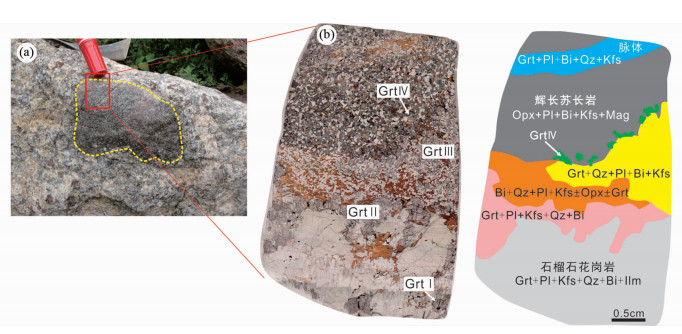
|
图 7 凉城石榴石花岗岩与基性包体之间的富石榴子石反应边的野外照片、显微照片及卡通示意图 根据石榴石的结构位置,我们将其分为4类:1)Grt Ⅰ,基性包体内侧围绕紫苏辉石生长的石榴石;2)Grt Ⅱ,富细粒石榴石层中的石榴石;3)Grt Ⅲ,富粗粒石榴石层中的石榴石;4)Grt Ⅳ,寄主花岗岩中的石榴石. 矿物缩写:Kfs-钾长石;Mag-磁铁矿 Fig. 7 Field photo, photomicrograph, and cartoon of the grt-rich reaction rim between the Liangcheng garnet granitoid and mafic enclave |
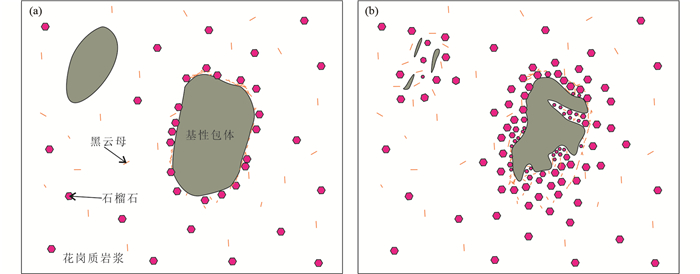
|
图 8 基性包体与花岗质岩浆反应示意图 Fig. 8 Cartoon illustrating reaction between mafic enclave and granitic magma |
从化学组分上来看,在SiO2与FeOT、MgO、CaO和K2O协变图上(图 4),石榴石花岗岩与实验熔体和辉长苏长岩呈现很好的线性关系,暗示石榴石花岗岩中可能存在辉长苏长岩的物质贡献。尤其值得指出的是,凉城石榴石花岗岩的CaO含量明显高于变质沉积岩和富石榴石相残留体(图 4),而且SiO2含量与A/CNK之间无明显负相关性,也说明富石榴石相残留体的带入不是控制着石榴石花岗岩成分向基性方向变化的唯一因素,幔源基性岩浆物质的加入是必不可缺的。在同位素方面,凉城石榴石花岗岩的锆石具有较大的Hf-O同位素组成变化范围(εHf(t)=-1.0~+5.6;δ18O=9.2‰~11.6‰),与辉长苏长岩中锆石的Hf-O同位素组成部分重合(εHf(t)=-2.9~+3.5;δ18O=7.7‰~10.9‰),暗示着两者之间存在强烈的组分交换和物质混合(Wang et al., 2018)。
5.4 成因模式综合上述考虑,我们认为富石榴石相残留体和幔源基性岩浆的物质贡献是造成凉城石榴石花岗岩低SiO2和富MgO+FeOT含量的两个主要因素。在判断是否存在物质混合时,元素比值-元素协变图比元素-元素协变图具有优势。若存在物质混合,在前者图中,数据呈双曲线式分布,而后者线性分布的数据则有多解性。Patiño Douce (1999)将主量元素分为Al2O3、FeO+MgO+TiO2、CaO、Na2O+K2O五组,并以其中两组主量之间的比值为纵坐标,以这两组主量加和为横坐标作图,可以彰显实验熔体、残留体和幔源基性物质之间成分的差异,并将此图用于有效判断花岗质岩浆是否有残留体和幔源基性物质的贡献。考虑到凉城石榴石花岗岩源岩以杂砂岩为主,我们选取杂砂岩的实验熔体平均成分、石榴石岩(残留体)和辉长岩,进行物质混合的主量元素质量平衡计算,以探讨不同组分的混合比例。在图 9上,凉城石榴石花岗岩总是落在熔体与石榴石岩和熔体与辉长苏长岩的混合曲线之间,显示出熔体、石榴石岩和辉长苏长岩三元混合的特点。模拟结果显示,凉城石榴石花岗岩需要20%~40%的石榴石岩和辉长苏长岩的物质贡献。另外,在模拟图中,辉长苏长岩沿着辉长岩与深熔熔体的混合曲线分布,指示辉长苏长岩受到深熔熔体或变质沉积岩组分的强烈混染。这也得到辉长苏长岩锆石较高的δ18O值和较低的εHf(t)特征的支持(Wang et al., 2018)。
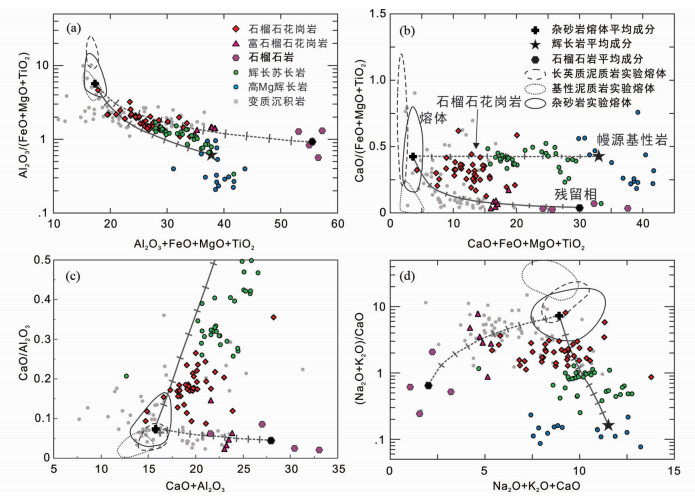
|
图 9 凉城石榴石花岗岩主量模拟计算图(据Wang et al., 2018) 模拟图底图来自Patiño Douce (1999),图内模拟演化线的每一个刻度代表 10% Fig. 9 Major elements modelling diagrams of the Liangcheng garnet granitoid (after Wang et al., 2018) |
本文用卡通图示意简单总结下凉城石榴石花岗岩的形成过程:1)造山作用导致地壳加厚,变质沉积岩埋藏到下地壳26~35km(8~10kbar)处,经历麻粒岩相变质作用,并发生一定程度的部分熔融(图 10a);2)徐武家基性岩墙侵入,进一步促进变质沉积岩的熔融,并在基性岩墙与变沉积岩之间反应形成石榴石岩(图 10b);3)大量基性岩浆底侵,变质沉积岩发生高程度部分熔融(30%~50%),固相矿物格架被打破,形成大量残留体悬浮在其中的岩浆房,同时基性岩浆与花岗岩浆发生一定程度的机械和化学混合,基性包体可与熔体反应形成石榴石岩(图 10c);4)熔体抽取,并裹挟石榴石岩、基性包体、残留体等小程度的上升侵位形成凉城石榴石花岗岩,同时基性包体可继续与熔体继续反应生成石榴石岩(图 10d)。值得强调的是,在变沉积岩高程度熔融后,熔体抽取时可以携带部分第2)阶段形成的石榴石岩,因此,基性岩浆对凉城石榴石花岗岩的物质贡献从第2)阶段开始,持续到第4)阶段。
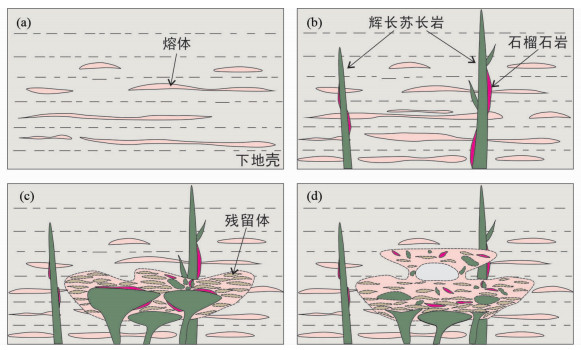
|
图 10 凉城石榴石花岗岩的岩石成因模式图(据Wang et al., 2018) Fig. 10 Petrogenetic diagram of the Liangcheng garnet granitoid (after Wang et al., 2018) |
凉城石榴石花岗岩是一种特殊的强过铝S型花岗岩,富含石榴子石(5%~25%),并常见紫苏辉石,具有低SiO2(55%~75%)、富MgO+FeOT(5%~14%)的成分特征,形成于高温、高压、低水活度的条件。在既有的ISAM花岗岩分类体系中,典型的S型花岗岩有两类,分别是白云母花岗岩和堇青石花岗岩(Barbarin, 1996, 1999)。这两类S型花岗岩具有正常花岗岩高SiO2和低MgO+FeOT的成分特征,形成条件分别是低温低压型和高温低压型。很显然,与上述两类典型的S型花岗岩都不同,凉城石榴石花岗岩是富含石榴子石的S型紫苏花岗岩,形成于高温、高压、低水活度的条件,是一种独立类型的S型花岗岩。
含紫苏辉石S型花岗岩(或者称为S型紫苏花岗岩)具有更高的岩浆形成温度(>850℃),因此相对少见。在Lachlan褶皱带,S型中酸性火山岩中可见紫苏辉石(Hawkins Suite和Violet Town Volcanics)(Wyborn et al., 1981; Clemens and Wall, 1984),也有个别含堇青石花岗岩体含紫苏辉石的报道(Maas et al., 1997)。在我国华南云炉-高州地区和十万大山地区也分布有含石榴石紫苏花岗岩(陈斌和庄育勋, 1994; Charoy and Barbey, 2008; Jiao et al., 2015; Zhao et al., 2017)。此外,含紫苏辉石S型花岗岩常与超高温变质作用密切相关。在十万大山地区旧州含堇青石紫苏辉石S型花岗岩中发现UHT麻粒岩包体(Zhao et al., 2012)。在日本北海道Hidaka变质带有紫苏石榴花岗岩报道,推测其形成温压条件为>900℃、8kbar(Shimura et al., 2004)。需要注意的是,这两个地区均发育同时代基性岩浆活动,可能为超高温变质作用和花岗岩形成提供了热量。在阿尔卑斯中部小规模石榴紫苏花岗岩出露于Gruf杂岩中,并在石榴紫苏花岗岩及其围岩中发现有含假蓝宝石UHT麻粒岩包体或析离体,推测石榴紫苏花岗岩形成于920~940℃,8.5~9.5kbar(Galli et al., 2011)。值得特别指出的是,Gruf杂岩中石榴紫苏花岗岩与凉城石榴紫苏花岗岩中的石榴子石和紫苏辉石具有相近的矿物成分,暗示二者形成于相近的温压条件。
致谢 感谢万渝生研究员的召集;感谢两位审稿人曾令森研究员和王孝磊教授对本文的认真评阅和建设性修改意见。
谨以此文祝贺沈其韩院士100华诞,并向先生致以崇高的敬意,祝愿先生健康长寿!
Allan BD and Clarke DB. 1981. Occurrence and origin of garnets in the South Mountain Batholith, Nova Scotia. The Canadian Mineralogist, 19: 19-24
|
Altherr R, Henjes-Kunst F, Langer C and Otto J. 1999. Interaction between crustal-derived felsic and mantle-derived mafic magmas in the Oberkirch Pluton (European Variscides, Schwarzwald, Germany). Contributions to Mineralogy and Petrology, 137(4): 304-322 DOI:10.1007/s004100050552
|
Appleby SK, Gillespie MR, Graham CM, Hinton RW, Oliver GJH and Kelly NM. 2010. Do S-type granites commonly sample infracrustal sources? New results from an integrated O, U-Pb and Hf isotope study of zircon. Contributions to Mineralogy and Petrology, 160(1): 115-132 DOI:10.1007/s00410-009-0469-3
|
Barbarin B. 1996. Genesis of the two main types of peraluminous granitoids. Geology, 24(4): 295-298 DOI:10.1130/0091-7613(1996)024<0295:GOTTMT>2.3.CO;2
|
Barbarin B. 1999. A review of the relationships between granitoid types, their origins and their geodynamic environments. Lithos, 46(3): 605-626 DOI:10.1016/S0024-4937(98)00085-1
|
Barbero L and Villaseca C. 1992. The Layos Granite, Hercynian Complex of Toledo (Spain): An example of parautochthonous restite-rich granite in a granulitic area. Earth and Environmental Science Transactions of the Royal Society of Edinburgh, 83(1-2): 127-138 DOI:10.1017/S0263593300007811
|
Cai J, Liu FL and Liu PH. 2017. Paleoproterozoic multistage metamorphic events in Jining metapelitic rocks from the Khondalite Belt in the North China Craton: Evidence from petrology, phase equilibria modelling and U-Pb geochronology. Journal of Asian Earth Sciences, 138: 515-534 DOI:10.1016/j.jseaes.2017.02.034
|
Castro A, Patiño Douce AE, Corretgé LG, de la Rosa JD, El-Biad M and El-Hmidi H. 1999. Origin of peraluminous granites and granodiorites, Iberian massif, Spain: An experimental test of granite petrogenesis. Contributions to Mineralogy and Petrology, 135(2-3): 255-276 DOI:10.1007/s004100050511
|
Chappell BW and White AJR. 1974. Two contrasting granite types. Pacific Geology, 8: 173-174
|
Chappell BW, White AJR and Wyborn D. 1987. The importance of residual source material (restite) in granite petrogenesis. Journal of Petrology, 28(6): 1111-1138 DOI:10.1093/petrology/28.6.1111
|
Chappell BW and White AJR. 1992. I- and S-type granites in the Lachlan Fold Belt. Earth and Environmental Science Transactions of the Royal Society of Edinburgh, 83(1-2): 1-26 DOI:10.1017/S0263593300007720
|
Chappell BW and White AJR. 2001. Two contrasting granite types: 25 years later. Australian Journal of Earth Sciences, 48(4): 489-499 DOI:10.1046/j.1440-0952.2001.00882.x
|
Charoy B and Barbey P. 2008. Ferromagnesian silicate association in S-type granites: The Darongshan granitic complex (Guangxi, South China). Bulletin De La Société Géologique De France, 179(1): 13-27 DOI:10.2113/gssgfbull.179.1.13
|
Chen B and Zhuang YX. 1994. The petrology and petrogenesis of Yunlu charmockite and its granulite inclusion, West Guangdong, South China. Acta Petrologica Sinica, 10(2): 139-150 (in Chinese with English abstract)
|
Clark RG Jr and Lyons JB. 1986. Petrogenesis of the Kinsman intrusive suite: Peraluminous granitoids of western New Hampshire. Journal of Petrology, 27(6): 1365-1393 DOI:10.1093/petrology/27.6.1365
|
Clemens JD and Wall VJ. 1984. Origin and evolution of a peraluminous silicic ignimbrite suite: The Violet Town volcanics. Contributions to Mineralogy and Petrology, 88(4): 354-371 DOI:10.1007/BF00376761
|
Clemens JD and Wall VJ. 1988. Controls on the mineralogy of S-type volcanic and plutonic rocks. Lithos, 21(1): 53-66 DOI:10.1016/0024-4937(88)90005-9
|
Clemens JD. 2003. S-type granitic magmas-petrogenetic issues, models and evidence. Earth-Science Reviews, 61(1-2): 1-18 DOI:10.1016/S0012-8252(02)00107-1
|
Clemens JD and Stevens G. 2012. What controls chemical variation in granitic magmas?. Lithos, 134-135: 317-329 DOI:10.1016/j.lithos.2012.01.001
|
Collins WJ. 1996. Lachlan Fold Belt granitoids: Products of three-component mixing. Transactions of the Royal Society of Edinburgh: Earth Sciences, 87(1-2): 171-181 DOI:10.1017/S0263593300006581
|
Dahlquist JA, Galindo C, Pankhurst RJ, Rapela CW, Alasino PH, Saavedra J and Fanning CM. 2007. Magmatic evolution of the Peñón Rosado granite: Petrogenesis of garnet-bearing granitoids. Lithos, 95(3-4): 177-207 DOI:10.1016/j.lithos.2006.07.010
|
Dorais MJ, Pett TK and Tubrett M. 2009. Garnetites of the Cardigan Pluton, New Hampshire: Evidence for peritectic garnet entrainment and implications for source rock compositions. Journal of Petrology, 50(1): 1993-2016
|
Dorais MJ and Tubrett M. 2012. Detecting peritectic garnet in the peraluminous Cardigan Pluton, New Hampshire. Journal of Petrology, 53(2): 299-324 DOI:10.1093/petrology/egr063
|
Dorais MJ and Spencer CJ. 2014. Revisiting the importance of residual source material (restite) in granite petrogenesis: The Cardigan Pluton, New Hampshire. Lithos, 202-203: 237-249 DOI:10.1016/j.lithos.2014.05.007
|
Elburg MA. 1996. Genetic significance of multiple enclave types in a peraluminous ignimbrite suite, Lachlan Fold Belt, Australia. Journal of Petrology, 37(6): 1385-1408 DOI:10.1093/petrology/37.6.1385
|
Farner MJ, Lee CTA and Putirka KD. 2014. Mafic-felsic magma mixing limited by reactive processes: A case study of biotite-rich rinds on mafic enclaves. Earth and Planetary Science Letters, 393: 49-59 DOI:10.1016/j.epsl.2014.02.040
|
Faryad SW, Kachlík V, Sláma J and Jedlicka R. 2016. Coincidence of gabbro and granulite formation and their implication for Variscan HT metamorphism in the Moldanubian Zone (Bohemian Massif), example from the Kutná Hora Complex. Lithos, 264: 56-69 DOI:10.1016/j.lithos.2016.08.005
|
Galli A, Le Bayon B, Schmidt MW, Burg JP, Caddick MJ and Reusser E. 2011. Granulites and charnockites of the Gruf Complex: Evidence for Permian ultra-high temperature metamorphism in the Central Alps. Lithos, 124(1-2): 17-45 DOI:10.1016/j.lithos.2010.08.003
|
Gray CM. 1984. An isotopic mixing model for the origin of granitic rocks in southeastern Australia. Earth and Planetary Science Letters, 70(1): 47-60 DOI:10.1016/0012-821X(84)90208-5
|
Green TH. 1976. Experimental generation of cordierite-or garnet-bearing granitic liquids from a pelitic composition. Geology, 4: 85-88 DOI:10.1130/0091-7613(1976)4<85:EGOCGG>2.0.CO;2
|
Guo JH and Zhai MG. 1992. Mylonite of granulite facies in Xuwujia, Nei Monggol. Scientia Geologica Sinica, 27(2): 190-192 (in Chinese with English abstract)
|
Guo JH, Shi X, Bian AG, Xu RH, Zhai MG and Li YG. 1999. Pb isotopic composition of feldspar and U-Pb age of zircon from early Proterozoic granite in Sanggan area, North China craton: Metamorphism, crustal melting and tectono-thermal event. Acta Petrologica Sinica, 15(2): 199-207 (in Chinese with English abstract)
|
Guo JH, Zhai MG and Xu RH. 2001. Timing of the granulite facies metamorphism in the Sanggan area, North China craton: Zircon U-Pb geochronology. Science in China (Series D), 44(11): 1010-1018 DOI:10.1007/BF02875394
|
Guo JH, Peng P, Chen Y, Jiao SJ and Windley BF. 2012. UHT sapphirine granulite metamorphism at 1.93~1.92Ga caused by gabbronorite intrusions: Implications for tectonic evolution of the northern margin of the North China Craton.. Precambrian Research, 222-223: 124-142 DOI:10.1016/j.precamres.2011.07.020
|
Healy B, Collins WJ and Richards SW. 2004. A hybrid origin for Lachlan S-type granites: The Murrumbidgee Batholith example. Lithos, 78(1-2): 197-216 DOI:10.1016/j.lithos.2004.04.047
|
Hopkinson TN, Harris NBW, Warren CJ, Spencer CJ, Roberts NMW, Horstwood MSA, Parrish RR and EIMF. 2017. The identification and significance of pure sediment-derived granites. Earth and Planetary Science Letters, 467: 57-63 DOI:10.1016/j.epsl.2017.03.018
|
Huang GY, Guo JH, Jiao SJ and Palin RM. 2019. What drives the continental crust to be extremely hot so quickly?. Journal of Geophysical Research: Solid Earth, 124(11): 11218-11231 DOI:10.1029/2019JB017840
|
Jiao SJ and Guo JH. 2011. Application of the two-feldspar geothermometer to ultrahigh-temperature (UHT) rocks in the Khondalite belt, North China craton and its implications. American Mineralogist, 96(2-3): 250-260 DOI:10.2138/am.2011.3500
|
Jiao SJ, Guo JH, Mao Q and Zhao RF. 2011. Application of Zr-in-rutile thermometry: A case study from ultrahigh-temperature granulites of the Khondalite belt, North China Craton. Contributions to Mineralogy and Petrology, 162(2): 379-393 DOI:10.1007/s00410-010-0602-3
|
Jiao SJ, Guo JH, Harley SL and Windley BF. 2013. New constraints from garnetite on the P-T path of the Khondalite Belt: Implications for the tectonic evolution of the North China Craton. Journal of Petrology, 54(9): 1725-1758 DOI:10.1093/petrology/egt029
|
Jiao SJ, Li XH, Huang HQ and Deng XG. 2015. Metasedimentary melting in the formation of charnockite: Petrological and zircon U-Pb-Hf-O isotope evidence from the Darongshan S-type granitic complex in southern China. Lithos, 239: 217-233 DOI:10.1016/j.lithos.2015.10.004
|
Keay S, Collins WJ and McCulloch MT. 1997. A three-component Sr-Nd isotopic mixing model for granitoid genesis, Lachlan fold belt, eastern Australia. Geology, 25(4): 307-310 DOI:10.1130/0091-7613(1997)025<0307:ATCSNI>2.3.CO;2
|
Kemp AIS, Hawkesworth CJ, Paterson BA, Foster GL, Kinny PD, Whitehouse MJ, Maas R and EIMF. 2008. Exploring the plutonic-volcanic link: A zircon U-Pb, Lu-Hf and O isotope study of paired volcanic and granitic units from southeastern Australia. Earth and Environmental Science Transactions of the Royal Society of Edinburgh, 97(4): 337-355 DOI:10.1017/S0263593300001498
|
Lackey JS, Erdmann S, Hark JS, Nowak RM, Murray KE, Clarke DB and Valley JW. 2011. Tracing garnet origins in granitoid rocks by oxygen isotope analysis: Examples from the South Mountain Batholith, Nova Scotia. Canadian Mineralogist, 49(2): 417-439 DOI:10.3749/canmin.49.2.417
|
Lackey JS, Romero GA, Bouvier AS and Valley JW. 2012. Dynamic growth of garnet in granitic magmas. Geology, 40(2): 171-174 DOI:10.1130/G32349.1
|
Li JH, Qian XL and Liu SW. 1999. Geochemical characteristics of khondalite series in middle part of North China Craton: Implications for continental cratonization. Science in China (Series D), 29: 193-203 (in Chinese)
|
Li XW and Wei CJ. 2016. Phase equilibria modelling and zircon age dating of pelitic granulites in Zhaojiayao, from the Jining Group of the Khondalite Belt, North China Craton. Journal of Metamorphic Geology, 34(6): 595-615 DOI:10.1111/jmg.12195
|
Li XW, White RW and Wei CJ. 2019. Can we extract ultrahigh-temperature conditions from Fe-rich metapelites? An example from the Khondalite Belt, North China Craton. Lithos, 328-329: 228-243 DOI:10.1016/j.lithos.2019.01.032
|
Liu SJ, Tsunogae T, Li WS, Shimizu H, Santosh M, Wan YS and Li JH. 2012. Paleoproterozoic granulites from Heling'er: Implications for regional ultrahigh-temperature metamorphism in the North China Craton. Lithos, 148: 54-70 DOI:10.1016/j.lithos.2012.05.024
|
Lobjoie C, Lin W, Trap P, Goncalves P, Li QL, Marquer D, Bruguier O and Devoir A. 2018. Ultra-high temperature metamorphism recorded in Fe-rich olivine-bearing migmatite from the Khondalite Belt, North China Craton. Journal of Metamorphic Geology, 36(3): 343-368 DOI:10.1111/jmg.12295
|
Lu LZ and Jin SQ. 1993. P-T-t paths and tectonic history of an Early Precambrian granulite facies terrane, Jining district, south-east Inner Mongolia, China. Journal of Metamorphic Geology, 11(4): 483-498 DOI:10.1111/j.1525-1314.1993.tb00166.x
|
Lu LZ, Xu XC and Liu FL. 1996. The Precambrian Khondalite Series in North China. Changchun: Changchun Publishing House (in Chinese)
|
Maas R, Nicholls IA and Legg C. 1997. Igneous and metamorphic enclaves in the S-type Deddick Granodiorite, Lachlan Fold Belt, SE Australia: Petrographic, geochemical and Nd-Sr isotopic evidence for crustal melting and magma mixing. Journal of Petrology, 38(7): 815-841 DOI:10.1093/petroj/38.7.815
|
Miller CF and Stoddard EF. 1981. The role of manganese in the paragenesis of magmatic garnet: An example from the Old Woman-Piute Range, California. The Journal of Geology, 89(2): 233-246 DOI:10.1086/628582
|
Montel JM and Vielzeuf D. 1997. Partial melting of metagreywackes, Part Ⅱ. Compositions of minerals and melts. Contributions to Mineralogy and Petrology, 128(2): 176-196 DOI:10.1007/s004100050302
|
Nabelek PI. 2019. Petrogenesis of leucogranites in collisional orogens. Geological Society, London, Special Publications, 491(1): 179-207
|
Patiño Douce AE and Johnston AD. 1991. Phase equilibria and melt productivity in the pelitic system: Implications for the origin of peraluminous granitoids and aluminous granulites. Contributions to Mineralogy and Petrology, 107(2): 202-218 DOI:10.1007/BF00310707
|
Patiño Douce AE and Harris N. 1998. Experimental constraints on Himalayan Anatexis. Journal of Petrology, 39(4): 689-710 DOI:10.1093/petroj/39.4.689
|
Patiño Douce AE and McCarthy TC. 1998. Melting of crustal rocks during continental collision and subduction. In: Hacker BR and Liou JG (eds.). When Continents Collide: Geodynamics and Geochemistry of Ultrahigh-Pressure Rocks. Netherlands: Springer, 27-55
|
Patiño Douce AE. 1999. What do experiments tell us about the relative contributions of crust and mantle to the origin of granitic magmas?. Geological Society, London, Special Publications, 168(1): 55-75 DOI:10.1144/GSL.SP.1999.168.01.05
|
Peng P, Guo JH, Zhai MG and Bleeker W. 2010. Paleoproterozoic gabbronoritic and granitic magmatism in the northern margin of the North China craton: Evidence of crust-mantle interaction. Precambrian Research, 183(3): 635-659 DOI:10.1016/j.precamres.2010.08.015
|
Peng P, Guo JH, Windley BF, Liu F, Chu ZY and Zhai MG. 2012. Petrogenesis of Late Paleoproterozoic Liangcheng charnockites and S-type granites in the central-northern margin of the North China Craton: Implications for ridge subduction. Precambrian Research, 222-223: 107-123 DOI:10.1016/j.precamres.2011.06.002
|
Peng P, Wang XP, Windley BF, Guo JH, Zhai MG and Li Y. 2014. Spatial distribution of ca.1950~1800Ma metamorphic events in the North China Craton: Implications for tectonic subdivision of the craton. Lithos, 202-203: 250-266 DOI:10.1016/j.lithos.2014.05.033
|
Qian Q and Hermann J. 2010. Formation of high-Mg diorites through assimilation of peridotite by monzodiorite magma at crustal depths. Journal of Petrology, 51(7): 1381-1416 DOI:10.1093/petrology/egq023
|
Ringuette L, Martignole J and Windley BF. 1999. Magmatic crystallization, isobaric cooling, and decompression of the garnet-bearing assemblages of the Jijal sequence (Kohistan terrane, western Himalayas). Geology, 27(2): 139-142 DOI:10.1130/0091-7613(1999)027<0139:MCICAD>2.3.CO;2
|
Rivalenti G, Mazzucchelli M, Barbieri MA, Parenti M, Schmid R and Zanetti A. 1997. Garnetite-forming processes in the deep crust: The Val Fiorina case study (Ivrea-Verbano Zone, NW Alps). European Journal of Mineralogy, 9(5): 1053-1072 DOI:10.1127/ejm/9/5/1053
|
Rosenberg CL and Handy MR. 2005. Experimental deformation of partially melted granite revisited: Implications for the continental crust. Journal of Metamorphic Geology, 23(1): 19-28 DOI:10.1111/j.1525-1314.2005.00555.x
|
Saleeby J, Ducea MN, Busby C, Nadin E and Wetmore PH. 2008. Chronology of pluton emplacement and regional deformation in the southern Sierra Nevada batholith, California. Geological Society of America Special Papers: 438
|
Sandeman HA and Clark AH. 2003. Glass-rich, cordierite-biotite rhyodacite, Valle Ninahuisa, Puno, SE Peru: Petrological evidence for hybridization of 'Lachlan S-type' and potassic mafic magmas. Journal of Petrology, 44(2): 355-385 DOI:10.1093/petrology/44.2.355
|
Santosh M, Sajeev K and Li JH. 2006. Extreme crustal metamorphism during Columbia supercontinent assembly: Evidence from North China Craton. Gondwana Research, 10(3-4): 256-266 DOI:10.1016/j.gr.2006.06.005
|
Santosh M, Tsunogae T, Li JH and Liu SJ. 2007. Discovery of sapphirine-bearing Mg-Al granulites in the North China Craton: Implications for Paleoproterozoic ultrahigh temperature metamorphism. Gondwana Research, 11(3): 263-285 DOI:10.1016/j.gr.2006.10.009
|
Shi X. 1997. Geochemistry and petrogenesis of granite in kondalites in southern Inner Mongolia. Master Degree Thesis. Beijing: Institute of Geology, Chinese Academy of Sciences (in Chinese)
|
Shi Q, Dong XJ, Xu ZY, Guan QB, Li PC, Zhang C and Cui FH. 2018. Anatectic origin and geological significance of the Paleoproterozoic gneissic garnet granite in the Jining area, northern margin of the North China Craton. Acta Petrologica Sinica, 34(9): 2754-2772 (in Chinese with English abstract)
|
Shimura T, Komatsu M and Iiyama JT. 1992. Genesis of the lower crustal garnet-orthopyroxene tonalites (S-type) of the Hidaka Metamorphic Belt, northern Japan. Earth and Environmental Science Transactions of the Royal Society of Edinburgh, 83(1-2): 259-268 DOI:10.1017/S026359330000794X
|
Shimura T, Owada M, Osanai Y, Komatsu M and Kagami H. 2004. Variety and genesis of the pyroxene-bearing S-and I-type granitoids from the Hidaka Metamorphic Belt, Hokkaido, northern Japan. Earth and Environmental Science Transactions of the Royal Society of Edinburgh, 95(1-2): 161-179 DOI:10.1017/S0263593300000997
|
Sinigoi S, Antonini P, Demarchi G, Longinelli A, Mazzucchelli M, Negrini L and Rivalenti G. 1991. Intractions of mantle and crustal magmas in the southern part of the Ivrea Zone (Italy). Contributions to Mineralogy and Petrology, 108(4): 385-395 DOI:10.1007/BF00303445
|
Stevens G, Clemens JD and Droop GTR. 1997. Melt production during granulite-facies anatexis: Experimental data from "primitive" metasedimentary protoliths. Contributions to Mineralogy and Petrology, 128(4): 352-370 DOI:10.1007/s004100050314
|
Stevens G, Villaros A and Moyen JF. 2007. Selective peritectic garnet entrainment as the origin of geochemical diversity in S-type granites. Geology, 35(1): 9-12 DOI:10.1130/G22959A.1
|
Stowell H, Parker KO, Gatewood M, Tulloch A and Koenig A. 2014. Temporal links between pluton emplacement, garnet granulite metamorphism, partial melting and extensional collapse in the lower crust of a Cretaceous magmatic arc, Fiordland, New Zealand. Journal of Metamorphic Geology, 32(2): 151-175 DOI:10.1111/jmg.12064
|
Sun SS and McDonough WF. 1989. Chemical and isotopic systematics of oceanic basalts: Implications for mantle composition and processes. In: Saunders AD and Norry MJ (eds.).Magmatism in the Ocean Basins.Geological Society, London, Special Publications, 42(1): 313-345
|
Sylvester PJ. 1998. Post-collisional strongly peraluminous granites. Lithos, 45(1-4): 29-44 DOI:10.1016/S0024-4937(98)00024-3
|
Tao JX and Hu FX. 2002. The formation of the garnet-bearing migmatitic granite in Zhuozishan area, Inner Mongolia, China. Progress in Precambrian Research, 25(1): 59-64 (in Chinese with English abstract)
|
Taylor J and Stevens G. 2010. Selective entrainment of peritectic garnet into S-type granitic magmas: Evidence from Archaean mid-crustal anatectites. Lithos, 120(3-4): 277-292 DOI:10.1016/j.lithos.2010.08.015
|
Tiepolo M, Tribuzio R and Langone A. 2011. High-Mg andesite petrogenesis by amphibole crystallization and ultramafic crust assimilation: Evidence from Adamello hornblendites (Central Alps, Italy). Journal of Petrology, 52(5): 1011-1045 DOI:10.1093/petrology/egr016
|
Vielzeuf D and Holloway JR. 1988. Experimental determination of the fluid-absent melting relations in the pelitic system. Contributions to Mineralogy and Petrology, 98(3): 257-276 DOI:10.1007/BF00375178
|
Vielzeuf D and Montel JM. 1994. Partial melting of metagreywackes. Part Ⅰ. Fluid-absent experiments and phase relationships. Contributions to Mineralogy and Petrology, 117(4): 375-393 DOI:10.1007/BF00307272
|
Vigneresse JL, Barbey P and Cuney M. 1996. Rheological transitions during partial melting and crystallization with application to felsic magma segregation and transfer. Journal of Petrology, 37(6): 1579-1600 DOI:10.1093/petrology/37.6.1579
|
Villaros A, Stevens G and Buick IS. 2009. Tracking S-type granite from source to emplacement: Clues from garnet in the Cape Granite Suite. Lithos, 112(3-4): 217-235 DOI:10.1016/j.lithos.2009.02.011
|
Wang F, Li XP, Chu H and Zhao GC. 2011. Petrology and metamorphism of khondalites from the Jining complex, North China craton. International Geology Review, 53(2): 212-229 DOI:10.1080/00206810903028144
|
Wang LJ, Guo JH, Peng P and Liu F. 2011. Metamorphic and geochronological study of garnet-bearing basic granulites from Gushan, the eastern end of the Khondalite Belt in the North China Craton. Acta Petrologica Sinica, 27(12): 3689-3700 (in Chinese with English abstract)
|
Wang LJ. 2015. Petrogenesis of Paleoproterozoic S-type granites in the Liangcheng area of the Khondalite Belt, North China Craton. Ph. D. Dissertation. Beijing: Institute of Geology and Geophysics, Chinese Academy of Sciences (in Chinese)
|
Wang LJ, Guo JH, Yin CQ and Peng P. 2017. Petrogenesis of ca. 1.95Ga meta-leucogranites from the Jining Complex in the Khondalite Belt, North China Craton: Water-fluxed melting of metasedimentary rocks. Precambrian Research, 303: 355-371 DOI:10.1016/j.precamres.2017.04.036
|
Wang LJ, Guo JH, Yin CQ, Peng P, Zhang J, Spencer CJ and Qian JH. 2018. High-temperature S-type granitoids (charnockites) in the Jining complex, North China Craton: Restite entrainment and hybridization with mafic magma. Lithos, 320-321: 435-453 DOI:10.1016/j.lithos.2018.09.035
|
White AJR and Chappell BW. 1977. Ultrametamorphism and granitoid genesis. Tectonophysics, 43(1-2): 7-22 DOI:10.1016/0040-1951(77)90003-8
|
White AJR, Chappell BW and Wyborn D. 1999. Application of the restite model to the Deddick granodiorite and its enclaves: A reinterpretation of the observations and data of Maas et al. (1997). Journal of Petrology, 40(3): 413-421 DOI:10.1093/petroj/40.3.413
|
Wickham SM. 1987. The segregation and emplacement of granitic magmas. Journal of the Geological Society, 144(2): 281-297 DOI:10.1144/gsjgs.144.2.0281
|
Williamson BJ, Downes H, Thirlwall MF and Beard A. 1997. Geochemical constraints on restite composition and unmixing in the Velay anatectic granite, French Massif Central. Lithos, 40(2-4): 295-319 DOI:10.1016/S0024-4937(97)00033-9
|
Wyborn D, Chappell BW and Johnston RM. 1981. Three S-type volcanic suites from the Lachlan Fold Belt, southeast Australia. Journal of Geophysical Research, 86(B11): 10335-10348 DOI:10.1029/JB086iB11p10335
|
Wyllie PJ. 1977. Crustal anatexis: An experimental review. Tectonophysics, 43(1-2): 41-71 DOI:10.1016/0040-1951(77)90005-1
|
Yang QY, Santosh M and Tsunogae T. 2014. Ultrahigh-temperature metamorphism under isobaric heating: New evidence from the North China Craton. Journal of Asian Earth Sciences, 95: 2-16 DOI:10.1016/j.jseaes.2014.01.018
|
Yin CQ, Zhao GC, Sun M, Xia XP, Wei CJ, Zhou XW and Leung W. 2009. LA-ICP-MS U-Pb zircon ages of the Qianlishan Complex: Constrains on the evolution of the Khondalite Belt in the Western Block of the North China Craton. Precambrian Research, 174(1-2): 78-94 DOI:10.1016/j.precamres.2009.06.008
|
Yin CQ, Zhao GC, Guo JH, Sun M, Xia XP, Zhou XW and Liu CH. 2011. U-Pb and Hf isotopic study of zircons of the Helanshan Complex: Constrains on the evolution of the Khondalite Belt in the Western Block of the North China Craton. Lithos, 122(1-2): 25-38 DOI:10.1016/j.lithos.2010.11.010
|
Zhai MG, Li YG, Guo JH, Zhang WH and Yan YH. 1996. Two linear granite zones in Shanxi-Hebei-Nei Mongol juncture region and their implication for early Precambrian continental evolution. Acta Petrologica Sinica, 12(2): 299-314 (in Chinese with English abstract)
|
Zhang HT, Li JH, Liu SJ, Li WS, Santosh M and Wang HH. 2012. Spinel+quartz-bearing ultrahigh-temperature granulites from Xumayao, Inner Mongolia Suture Zone, North China Craton: Petrology, phase equilibria and counterclockwise P-T path. Geoscience Frontiers, 3(5): 603-611 DOI:10.1016/j.gsf.2012.01.003
|
Zhao GC, Sun MR and Wilde SA. 2003. Major tectonic units of the North China Craton and their Paleoproterozoic assembly. Science in China (Series D), 46(7): 23-38
|
Zhao GC, Sun M, Wilde SA and Li SZ. 2005. Late Archean to Paleoproterozoic evolution of the North China Craton: Key issues revisited. Precambrian Research, 136(2): 177-202 DOI:10.1016/j.precamres.2004.10.002
|
Zhao K, Xu XS and Erdmann S. 2017. Crystallization conditions of peraluminous charnockites: Constraints from mineral thermometry and thermodynamic modelling. Contributions to Mineralogy and Petrology, 172(5): 26 DOI:10.1007/s00410-017-1344-2
|
Zhao L, Guo F, Fan WM, Li CW, Qin XF and Li HX. 2012. Origin of the granulite enclaves in Indo-Sinian peraluminous granites, South China and its implication for crustal anatexis. Lithos, 150: 209-226 DOI:10.1016/j.lithos.2012.02.015
|
Zhong CT, Deng JF, Wan YS, Mao DB and Li HM. 2007. Magma recording of Paleoproterozoic orogeny in central segment of northern margin of North China craton: Geochemical characteristics and zircon SHRIMP dating of S-type granitoids. Geochimica, 36(6): 585-600 (in Chinese with English abstract)
|
陈斌, 庄育勋. 1994. 粤西云炉紫苏花岗岩及其麻粒岩包体的主要特点和成因讨论. 岩石学报, 10(2): 139-150. |
郭敬辉, 翟明国. 1992. 徐武家麻粒岩相糜棱岩. 地质科学, 27(2): 190-192. |
郭敬辉, 石昕, 卞爱国, 许荣华, 翟明国, 李永刚. 1999. 桑干地区早元古代花岗岩长石Pb同位素组成和锆石U-Pb年龄: 变质与地壳熔融作用及构造-热事件演化. 岩石学报, 15(2): 199-207. |
郭敬辉, 翟明国, 许荣华. 2002. 华北桑干地区大规模麻粒岩相变质作用的时代: 锆石U-Pb年代学. 中国科学(D辑), 32(1): 10-18. |
李江海, 钱祥麟, 刘树文. 1999. 华北克拉通中部孔兹岩系的地球化学特征及其大陆克拉通化意义. 中国科学(D辑), 29(3): 193-203. |
卢良兆, 徐学纯, 刘福来. 1996. 中国北方早前寒武纪孔兹岩系. 长春: 长春出版社.
|
石昕. 1997. 内蒙古南部孔兹岩系中花岗岩的地球化学和成因研究. 硕士学位论文. 北京: 中国科学院地质研究所
|
石强, 董晓杰, 徐仲元, 关庆彬, 李鹏川, 张超, 崔芳华. 2018. 华北地台北缘集宁地区古元古代片麻状石榴花岗岩的深熔成因及地质意义. 岩石学报, 34(9): 2754-2772. |
陶继雄, 胡凤翔. 2002. 内蒙卓资山地区深熔作用形成的石榴混合花岗岩. 前寒武纪研究进展, 25(1): 59-64. |
王洛娟, 郭敬辉, 彭澎, 刘富. 2011. 华北克拉通孔兹岩带东端孤山剖面石榴石基性麻粒岩的变质作用及年代学研究. 岩石学报, 27(12): 3689-3700. |
王洛娟. 2015. 华北克拉通孔兹岩带凉城地区古元古代S型花岗岩成因研究. 博士学位论文. 北京: 中国科学院地质与地球物理研究所
|
翟明国, 李永刚, 郭敬辉, 张雯华, 阎月华. 1996. 晋冀内蒙交界地区麻粒岩地体中两条花岗岩带及其对早前寒武纪地壳生长的意义. 岩石学报, 12(2): 299-314. |
钟长汀, 邓晋福, 万渝生, 毛德宝, 李惠民. 2007. 华北克拉通北缘中段古元古代造山作用的岩浆记录: S型花岗岩地球化学特征及锆石SHRIMP年龄. 地球化学, 36(6): 585-600. |
 2021, Vol. 37
2021, Vol. 37

